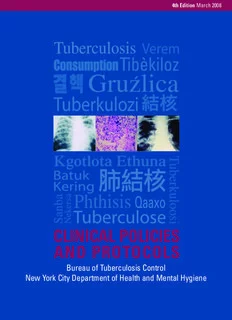
CLINICAL POLICIES AND PROTOCOLS PDF
Preview CLINICAL POLICIES AND PROTOCOLS
4th Edition March 2008 CLINICAL POLICIES AND PROTOCOLS Bureau of Tuberculosis Control New York City Department of Health and Mental Hygiene Abbreviations AAP AmericanAcademyofPediatrics MAC mycobacteriumaviumcomplex ACH airchangesperhour MAI mycobacteriumaviumintracellulare AFB acid-fastbacilli M.bovis mycobacteriumbovis AII airborneinfectionisolation MDRTB multidrug-resistanttuberculosis ALT alaninetransaminase MGIT MycobacterialGrowthIndicatorTube AMA againstmedicaladvice MIRU mycobacterialinterspersal ANA antinuclearantibody repetitiveunits ATS AmericanThoracicSociety MOTT mycobacteriumotherthan tuberculosis,NTM BCG BacilleCalmette-Guérin MMR measles,mumpsand/orrubella BP basepairs MRI magneticresonanceimaging BTBC BureauofTuberculosisControl M.tb mycobacteriumtuberculosis CBC completebloodcount MTD MycobacteriumTuberculosisDirect® CDC CentersforDiseaseControl andPrevention NAA nucleicacidamplification CDC/DGMQ CDCDivisionofGlobalMigration NIOSH NationalInstituteforOccupational andQuarantine SafetyandHealth CFM cubicfeetperminute NJMRC NationalJewishMedicaland ResearchCenter CFP-10 culturefiltrateprotein-10 NNRTIs non-nucleosidereversetranscriptase CI contactinvestigation inhibitors CNS centralnervoussystem NTM nontuberculosismycobacterium,MOTT CSF cerebrospinalfluid NYCDOHMH NewYorkCityDepartmentofHealth CT computedtomography andMentalHygiene CXR chestX-ray NYPHL NewYorkCityBureauofPublic DOS DepartmentofState HealthLaboratories DOT directlyobservedtherapy PCR polymerasechainreaction DR directrepeat PHA publichealthadvisor DRTB drugresistanttuberculosis PHI protectedhealthinformation ECLRS ElectronicClinicalLaboratory PIs proteaseinhibitors ReportingSystem PPD purifiedproteinderivative EDN ElectronicDiseaseNotification QFT-G QuantiFERON©-TBGold EDTA ethylenediaminetetraaceticacid RFLP restrictionfragmentlength ELISA enzyme-linkedimmunosorbentassay polymorphism ESAT-6 EarlySecretoryAntigenicTarget-6 RTS returntosupervision FP false-positive SDN SecureDataNetwork HAART highlyactiveantiretroviraltherapy SLE systemiclupuserythematosus HEPA high-efficiencyparticulateair SPC singlepositiveculture HHS U.S.DepartmentofHealthandHuman SSRIs selectiveserotoninreuptakeinhibitors Services SST serumseparatortubes HIPAA TheHealthInsurancePortabilityand TB tuberculosis AccountabilityActof1966 TDM therapeuticdrugmonitoring HIV HumanImmunodeficiencyVirus TI TechnicalInstructionsforMedical IDPL InfectiousDiseasesPharmacokinetics ExaminationofAliens Laboratory TST tuberculinskintest IDSA InfectiousDiseasesSocietyofAmerica TTBI testfortuberculosisinfection INA ImmigrationandNaturalizationAct UGVI ultravioletgermicidalirradiation IND investigationalnewdrug ULN upperlimitsnormal IFN-g interferon-gamma URF UniversalReportingForm IRIS immunereconstitutionsyndrome USCIS UnitedStatesCitizenshipand IRU ImmigrationandRefugeeUnit ImmigrationServices LFTs liverfunctiontests WHO WorldHealthOrganization LTBI latenttuberculosisinfection XDRTB extremelydrugresistanttuberculosis Clinical Policies and Protocols Bureau of Tuberculosis Control New York City Department of Health and Mental Hygiene 4th Edition March 2008 Content: Sonal S. Munsiff, MD Diana Nilsen, MD, RN Paula I. Fujiwara, MD, MPH Editorial: Cortnie Lowe, MFA, Executive Editor, Bureau of Communications Lise Millay Stevens, MA, Deputy Director, Editor Melissa Burdick Harmon, MA, Senior Editor Additional Contributions: Joseph Burzynski, MD, MPH Marie Dorsinville, RN, MPH Cynthia Driver, RN, DrPH Chrispin Kambili, MD Liza King, MPH Ann Winters, MD WethanktheadministrativestaffattheBTBCExecutiveOffice,especially JasmineHyltonforherextensiveadministrativeassistance,andalltheBTBCand non-BTBCphysiciansandstaffwhoreadthemanuscriptandofferedcomments. www.nyc.gov/health/tb Table of Contents Section I. Section II. Introduction to the 4th Edition Initial Evaluation of Suspected Tuberculosis Director’sStatement...............................................11 PathogenesisofTuberculosis...............................25 Aboutthe4thEdition...............................................12 Transmission,infectionandproliferation....25 The2003nationalguidelines..............................12 Hostimmuneresponse...................................25 Rifapentine.......................................................12 Inflammation,necrosisand Useoffluoroquinolones cavityformation...............................................25 inthetreatmentoftuberculosis ..................13 BTBCguidelinesvs. PhysicalEvaluationofAdultsandChildren.......26 ATS/CDC/IDSAguidelines.............................13 RadiographicEvaluation........................................27 Treatmentofpatientswhoareco-infected withtuberculosisandHIV...............................14 MicrobiologicEvaluation......................................27 Hospitalizationanddischargeguidelines....14 Specimencollection........................................27 Targetedtestingand Nucleicacidamplification............................30 latenttuberculosisinfection.........................15 Culture................................................................31 Keysources........................................................15 Speciesidentification.....................................32 Appendices........................................................15 Drugsusceptibilitytesting............................32 TuberculosisSurveillanceandEpidemiology.......15 Genotyping........................................................34 Surveillance.........................................................15 False-positiveresults......................................35 Objectivesoffalse-positive Tuberculosisepidemiology M.tbspecimeninvestigations......................35 inNewYorkCity..............................................16 Methodsusedtoidentify ConfidentialityandHealthInsurancePortability false-positiveM.tbcultures..........................35 andAccountabilityActRegulations....................16 Interpretingresultsofthe Lawsgoverningconfidentiality....................16 false-positiveinvestigation............................36 HIPAAprivacyrule..........................................17 OtherLaboratoryTests............................................36 Talkingtotuberculosispatients andcontacts......................................................18 ClassificationofSuspected TuberculosisPatients.............................................36 Exceptionstoconfidentialityrules..............18 TuberculosisinChildhood.....................................37 MissionStatement..................................................20 Medicalevaluation..........................................37 KeySources.............................................................21 ChestX-rayinchildren..................................37 Congenitalandneonataltuberculosis......38 Evaluatingneonatesfortuberculosis.........38 BacilleCalmette-Guérinvaccination.........38 KeySources.............................................................40 NewYorkCityDepartmentofHealthandMentalHygiene 1 Table of Contents Section III. RegimensforPatients Treatment of Pulmonary Tuberculosis withChronicRenalFailure....................................60 RegimensforPatientswithLiverDisease..........61 RegimensforTreatmentof Drug-SusceptibleTuberculosis............................43 TheUseofPyridoxine(VitaminB ) 6 Standardregimen.............................................43 inTuberculosisTreatment......................................62 Lengthoftreatment ..........................................43 Anti-TuberculosisDrugsandMeals....................62 IntermittentRegimens............................................44 DirectlyObservedTherapy....................................63 Rifapentine...............................................................46 Protocolforproviding directlyobservedtherapy..............................63 Patientselection...............................................46 Priorityofpatientsfor Treatmentlength..............................................48 directlyobservedtherapy..............................64 Dosing.................................................................48 Monitoring..........................................................48 DeterminationofTreatmentCompletion..............64 Adversereactions............................................48 Interruptedorincompletetreatment...........65 Useinpregnantand Renewaloftuberculosistreatment.............65 breast-feedingwomen....................................48 Continuationoflapsedtreatment...............65 Useinchildren..................................................48 Protocolsforreinstitutingtreatment...........65 Druginteractions.............................................48 Treatmentfailure..............................................67 TreatmentofCo-existentTuberculosisandHIV....49 Treatmentofcoexistenttuberculosis Antiretroviraldrugsandrifamycins...........49 anddisseminatedMycobacterium avium-intracellulare.......................................67 Treatmentoptions............................................52 Generalconsiderations..................................52 KeySources.............................................................68 Immunereconstitution inflammatorysyndrome.................................56 Section IV. RegimensforPregnantWomen............................56 Evaluation and Treatment of Standardregimenforpregnantwomen.......57 Extrapulmonary Tuberculosis Lengthoftreatment.........................................57 LymphaticTuberculosis..........................................72 Regimen for pregnant women Diagnosis...........................................................72 suspected or known to have tuberculosis resistant to isoniazid and rifampin Treatment...........................................................72 (MDRTB)..............................................................58 PleuralTuberculosis...............................................72 Anti-tuberculosismedications Diagnosis...........................................................73 inbreast-feedingwomen...............................58 Treatment...........................................................73 RegimensforChildren............................................59 PericardialTuberculosis........................................73 Standardregimen............................................59 Diagnosis...........................................................73 Lengthoftreatmentregardless Treatment...........................................................73 ofcultureresults...............................................60 Adverseeventsinchildren............................60 2 TuberculosisClinicalPoliciesandProtocols,4thEdition Table of Contents CentralNervousSystemTuberculosis.................73 SuggestedRegimensforSpecific DrugResistancePatterns......................................85 Diagnosisofmeningealtuberculosis.........73 Isoniazidresistance.........................................87 Treatmentofmeningealtuberculosis.........74 (withorwithoutstreptomycinresistance) Tuberculoma......................................................75 Isoniazidandethambutolresistance.........87 DisseminatedTuberculosis...................................75 (withorwithoutstreptomycinresistance) Diagnosis...........................................................76 Rifampinresistance........................................87 Treatment...........................................................76 (withorwithoutstreptomycinresistance) SkeletalTuberculosis.............................................76 Isoniazidandrifampinresistance...............88 (withorwithoutstreptomycinresistance) Diagnosis...........................................................76 Isoniazid,rifampinand Treatment...........................................................76 ethambutolresistance ...................................89 GenitourinaryTuberculosis...................................76 (withorwithoutstreptomycinresistance) Diagnosis...........................................................76 Isoniazid,rifampin Treatment...........................................................76 andpyrazinamideresistance.......................89 (withorwithoutstreptomycinresistance) GastrointestinalTuberculosis...............................77 Isoniazid,rifampin,pyrazinamide Diagnosis...........................................................77 andethambutolresistance............................90 Treatment...........................................................77 (withorwithoutstreptomycinresistance) PeritonealTuberculosis.........................................77 Isoniazid,rifampin,ethambutol, Diagnosis...........................................................77 streptomycin,kanamycin,ethionamide andrifabutinresistance(“StrainW”).........90 Treatment...........................................................77 Isoniazid, rifampin, ethambutol, CutaneousTuberculosis.........................................77 streptomycin, fluoroquinolone Diagnosis...........................................................78 resistance(withorwithoutpyrazinamide Treatment...........................................................78 orseveralinjectableagents).........................91 DiseaseDuetoIntravesicalBacille UseofNewerFluoroquinolones Calmette-GuérinforBladderCancer.....................78 forTreatingTuberculosis.......................................91 Diagnosis...........................................................78 ToxicitiesofFluoroquinolones..............................92 Treatment...........................................................78 Photosensitivityandcardiotoxicity.............92 KeySources.............................................................80 Tendinopathy/tendonitis................................92 Hypoglycemiaandhyperglycemia.............93 Section V. Long-termuseoffluoroquinolones..............93 TreatmentofDrug-ResistantTuberculosis Moxifloxacin......................................................93 PrinciplesofTreatingDrug-Resistant Linezolid....................................................................94 Tuberculosis.............................................................83 Clofazamine..............................................................95 Treatmentprinciples.......................................83 MonitoringandPost-TreatmentEvaluation........95 Monitoringprinciples......................................84 SurgeryforPulmonaryTuberculosis....................95 Principlesforselecteddrugs........................85 NewYorkCityDepartmentofHealthandMentalHygiene 3 Table of Contents Indicationsforsurgery....................................96 KeySources...........................................................118 Protocolforsurgeryreferral..........................96 KeySources.............................................................97 Section VII. Infection Control Section VI. GuidelinesforHospitalAdmissionand Clinical Monitoring and Follow-up OutpatientManagementofPatientswith for Tuberculosis Treatment SuspectedorConfirmedTuberculosis...............121 Whentoadmitapatientwith MonthlyClinicalEvaluation................................101 suspectedorconfirmedtuberculosis........121 Physicianassessment...................................101 Whennottoadmitapatientwith Nurseassessment..........................................105 suspectedorconfirmedtuberculosis........122 ManagementofAdverseReactions...................106 AirborneInfectionIsolation................................122 Dermatitis.........................................................106 Initiatingairborneinfectionisolation......122 Hepatitis...........................................................107 Dischargefromairborne Gastritis............................................................110 infectionisolation..........................................124 Peripheralneuropathy..................................110 Transfertoanonairborne isolationarea..................................................124 Jointmanifestations......................................111 Influenceofnucleicacidamplification Renalmanifestations....................................111 onairborneinfectionisolation...................125 Hematologicmanifestations.......................111 GuidelinesforReturningSuspectedor Visualmanifestations...................................112 KnownTuberculosisPatientstoHome..............125 Audiovestibularmanifestations................112 Patientswhocanbedischarged Drugdesensitization.....................................113 fromthehospital............................................125 Paradoxicalreactions,non-HIVrelated...113 Patientswhoshouldnotbedischarged Reportingadverseevents............................114 fromthehospitalwhilestillAFBsmear positiveormovedtoanonairborne Gradesoftoxicity...........................................114 isolationroom.................................................126 ReclassificationofPatients DischargeofanAFBsmear-negative SuspectedofHavingTuberculosis.....................114 individualdirectlyfromthehospital (suspectednon-MDRTB)................................126 CaseClosingand End-of-TreatmentEvaluation...............................115 Dischargeofanindividualwith knownorsuspectedMDRTB........................126 Post-TreatmentEvaluation...................................115 GuidelinesforReturningPatientstoWork, Candidatesandproceduresfor post-treatmentevaluation............................115 SchoolorOtherCongregateSettings................127 Specialconsiderations SputumAFBsmear-positivepatients forpatientswhoareHIVpositive..............117 knownorlikelytohavedrug-susceptible tuberculosis.....................................................127 Theuseofisoniazidafter completionoftuberculosistreatment.......117 4 TuberculosisClinicalPoliciesandProtocols,4thEdition Table of Contents SputumAFBsmear-negativepatients Theinitialinterview......................................139 knownorlikelytohavedrug-susceptible EnsuringEffectiveCaseManagement...............139 tuberculosis.....................................................127 Casemanagerinitialinterviewtopics....141 Patientsknownorlikelytohave multidrug-resistanttuberculosis...............129 EnsuringAdherence.............................................142 HomeIsolation.......................................................129 Commonproblemswith,andearly indicatorsof,pooradherence.....................142 InfectionControlIssuesinPregnancy andthePeripartumPeriod...................................130 Return-to-SupervisionActivities........................143 Pregnantwomenwithlatent Follow-upforpatientswithtuberculosis tuberculosisinfection....................................130 whohavemissedvisitsandforsuspected casesnotondirectlyobservedtherapy......143 InfectionControlinChestCenters.....................131 Follow-uponmisseddirectly Triage................................................................131 observedtherapyvisits..................................143 Temporaryisolation......................................131 Prioritizingpatientsforfurther Masksandparticulaterespirators............131 returntosupervision.....................................143 SputumInduction..................................................132 CohortReview.......................................................143 Staffinvolvedinsputuminduction...........132 Prioritizationforlocating nonadherentpatients.....................................144 Equipment........................................................132 Nonadherentpatientswhoshouldbe Preparingequipmentand referredfordetention......................................145 thesputuminductionroom..........................132 RegulatoryInterventionOptions.........................145 Preparingthepatient....................................133 Commissioner’sorders.................................145 Roleofchestcenterstaffduring theinductionprocedure...............................133 Tuberculosis-relatedregulatory interventionssectionsofthecurrent Handlingofthespecimen............................133 HealthCode.....................................................147 Careofequipment Proceduresforinfectiousor andareabetweenuses................................133 potentiallyinfectiouspatients Careofroomandnebulizer whowanttoleavethehospital..................148 attheendoftheday......................................134 Documentation................................................134 KeySources...........................................................149 KeySources...........................................................135 Section IX. Contact Evaluation and Section VIII. Public Health Management Case Management of Suspected Cases and Patients with Tuberculosis ImportanceofContactEvaluation......................153 in the Field and Clinic Definitions........................................................153 InitialCaseManagement.....................................139 Confidentiality................................................155 Objectivesofcasemanagement................139 NewYorkCityDepartmentofHealthandMentalHygiene 5 Table of Contents EpidemiologicalAssessment Section X. ofTransmission......................................................155 Testing for Latent PrioritiesforContactInvestigation....................155 Tuberculosis Infection CalculatingtheInfectiousPeriod.......................161 CandidatesforTesting forLatentTuberculosisInfection........................173 AssessingRiskofTransmission.........................161 Prioritiesfortesting.......................................173 EvaluationandManagementofContacts.........161 Testingpregnantwomen.............................176 Symptomreview.............................................161 Guidelinesfortesting HIVscreeningandtesting...........................162 specifichigh-riskgroups..............................176 Initialtestfortuberculosisinfection AdministeringtheTuberculinSkinTest............178 andfollow-up..................................................162 Preparation......................................................178 Medicalevaluation andchestradiograph....................................163 Injection............................................................178 Repeattestfortuberculosisinfection Post-injection...................................................178 andfollow-up..................................................163 ReadingtheTuberculinSkinTestReaction......179 Contactevaluationforpatientswhose culturesconvertbacktopositive...............164 Interpretationofthe TuberculinSkinTestReaction............................179 SpecialConsiderationsfor InfantandChildContacts.....................................164 InterpretationoftheTuberculin SkinTestinBacilleCalmette-Guérin- Initialtestfortuberculosisinfection VaccinatedIndividuals.........................................179 andchestX-rayforinfantsandchildren...164 Repeattestfortuberculosisinfection RoleofAnergyTesting.........................................182 andchestX-rayforinfantsandchildren...165 Two-StepTuberculinSkinTesting......................182 ContactInvestigationforSmear-Negative, Background......................................................182 Culture-PendingCases.........................................165 Candidatesandprocedure ExpandingaContactInvestigation.....................165 for2-steptesting.............................................183 AirlineExposures..................................................167 Blood-BasedTestsforTuberculosisInfection: TheQuantiFERON®-GoldTest..............................183 SourceCaseInvestigationfor AdvantagesoftheQFT-Gtest....................183 PediatricTuberculosisCases..............................167 LimitationsoftheQFT-Gtest......................184 CaseManagementandTreatmentofContacts Eligibilityandinterpretationof withLatentTuberculosisInfection.....................169 theresultsoftheQFT-Gtest.......................184 Responsibilitiesofthecasemanager......169 CostsandbenefitsoftheQFT-Gtest........184 Returntosupervisionprocedures Futureblood-basedassays.........................184 forcontactsbeingtreatedforlatent tuberculosisinfection....................................169 KeySources...........................................................185 KeySources...........................................................170 6 TuberculosisClinicalPoliciesandProtocols,4thEdition Table of Contents Section XI. Regimensforwomenwhobecome LatentTuberculosisInfection:Evaluation, pregnantwhiletakingtreatment forlatenttuberculosisinfection.................200 Treatment, Monitoring and Follow-up Regimensforindividualswithradiographic ClinicalEvaluation................................................189 evidenceofold,healedtuberculosis (ClassesIVandV)..........................................200 Medicalhistoryand physicalexamination...................................189 Treatmentofclosecontactswithaprior ChestX-ray......................................................189 positivetestfortuberculosisinfection........202 PatientchestX-rayclassifications............189 CaseManagementofPatientswithLatent Laboratorytestsforindividualsbeing TuberculosisInfection .........................................202 consideredforlatenttuberculosis MonitoringPatientsDuringTreatment..............202 infectiontreatment........................................190 CandidatesforTreatmentfor Howproviderscanassessand promoteadherence........................................203 LatentTuberculosisInfection..............................192 Individualswhomayhave EnsuringAdherenceDuringTreatment..............203 beenrecentlyinfected..................................192 ManagingInterruptionsinTreatment................203 Patientswithclinicalconditionsassociated CompletingTreatment...........................................205 withprogressionfromlatenttuberculosis toactivetuberculosis....................................192 Follow-upforPatientsWhoHaveCompleted Personswithimmunosuppressive Treatment................................................................205 conditionsorwhoarebeingtreated KeySources...........................................................206 withimmunosuppressiveagents...............192 Contactswhoshouldstarttreatment Appendices regardlessoftuberculinskin testreaction.....................................................193 AppendixI-A Pregnantwomenascandidatesfor DosagesforPrimaryMedications latenttuberculosisinfectiontreatment....193 UsedintheTreatmentofTuberculosis.....208 Childrenascandidatesforlatent AppendixI-B tuberculosisinfectiontreatment................193 DosagesforReserveMedications LatentTuberculosisInfection UsedintheTreatmentofTuberculosis.....210 TreatmentRegimens.............................................195 AppendixI-C Standardregimen:isoniazid.......................195 TheUseofAntituberculosisDrugsDuring Alternativeregimen:rifampin....................195 Pregnancy,Breastfeeding,Tuberculosis Meningitis,andRenalandHepatic Rifampinandpyrazinamide.......................198 Failure..................................................................211 Alternativeregimensforcontactsof AppendixI-D personswithisoniazid-andrifampin- resistanttuberculosis(multidrug- LateComplicationsofTreated resistantcontacts).........................................198 PulmonaryTuberculosis...............................212 NewYorkCityDepartmentofHealthandMentalHygiene 7
Description: